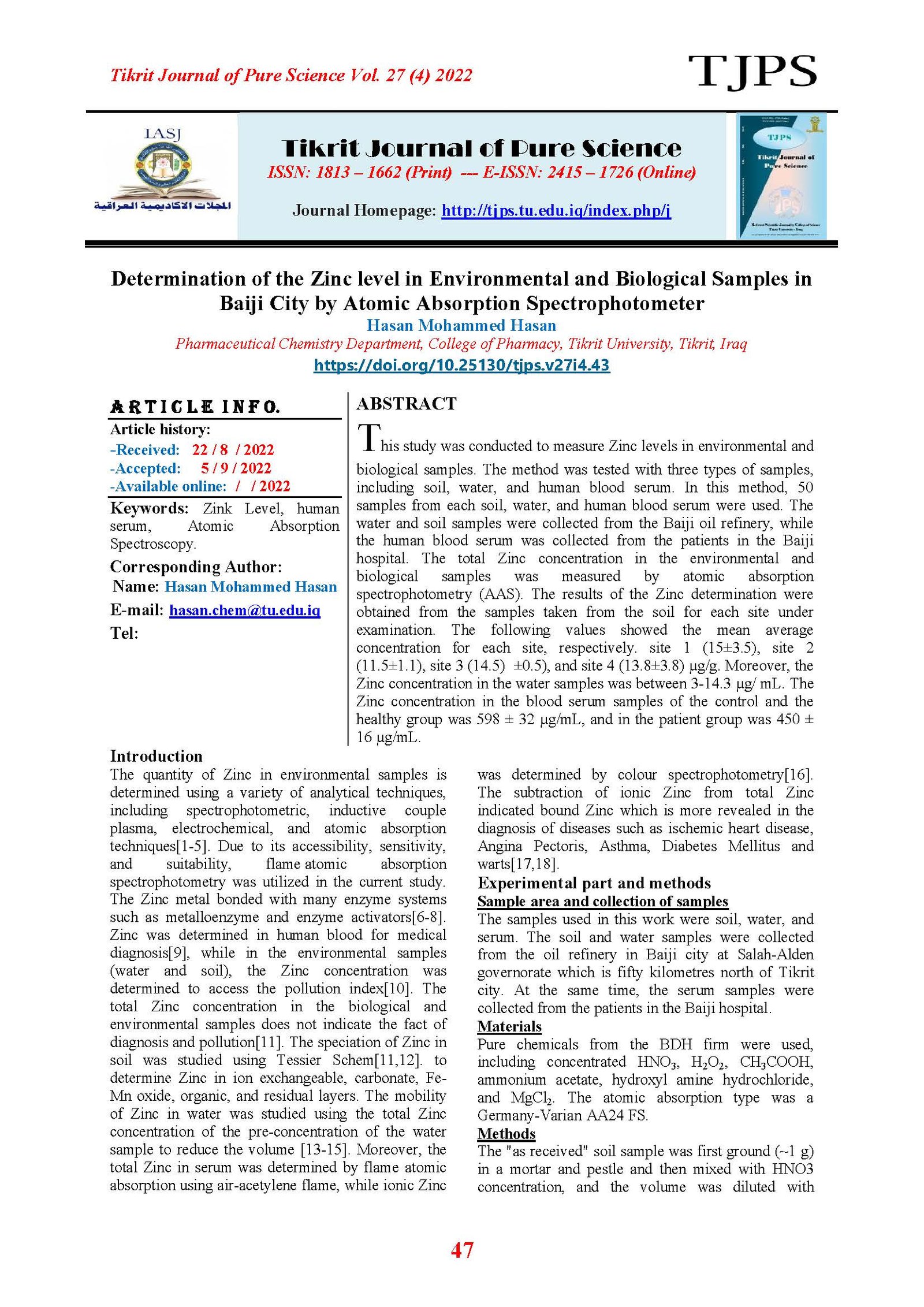Determination of the Zinc level in Environmental and Biological Samples in Baiji City by Atomic Absorption Spectrophotometer
Main Article Content
Abstract
This study was conducted to measure Zinc levels in environmental and biological samples. The method was tested with three types of samples, including soil, water, and human blood serum. In this method, 50 samples from each soil, water, and human blood serum were used. The water and soil samples were collected from the Baiji oil refinery, while the human blood serum was collected from the patients in the Baiji hospital. The total Zinc concentration in the environmental and biological samples was measured by atomic absorption spectrophotometry (AAS). The results of the Zinc determination were obtained from the samples taken from the soil for each site under examination. The following values showed the mean average concentration for each site, respectively. site 1 (15±3.5), site 2 (11.5±1.1), site 3 (14.5) ±0.5), and site 4 (13.8±3.8) µg/g. Moreover, the Zinc concentration in the water samples was between 3-14.3 µg/ mL. The Zinc concentration in the blood serum samples of the control and the healthy group was 598 ± 32 µg/mL, and in the patient group was 450 ± 16 µg/mL.
Article Details

This work is licensed under a Creative Commons Attribution 4.0 International License.
Tikrit Journal of Pure Science is licensed under the Creative Commons Attribution 4.0 International License, which allows users to copy, create extracts, abstracts, and new works from the article, alter and revise the article, and make commercial use of the article (including reuse and/or resale of the article by commercial entities), provided the user gives appropriate credit (with a link to the formal publication through the relevant DOI), provides a link to the license, indicates if changes were made, and the licensor is not represented as endorsing the use made of the work. The authors hold the copyright for their published work on the Tikrit J. Pure Sci. website, while Tikrit J. Pure Sci. is responsible for appreciate citation of their work, which is released under CC-BY-4.0, enabling the unrestricted use, distribution, and reproduction of an article in any medium, provided that the original work is properly cited.
References
[1] Abed, S. A., Ewaid, S. H., & Al-Ansari, N. (2019, September). Evaluation of water quality in the Tigris River within Baghdad, Iraq using multivariate statistical techniques. In Journal of Physics: Conference Series (Vol. 1294, No. 7, p. 072025). IOP Publishing.
[2] Ramal, M. M., Jalal, A. D., & Abdulhameed, U. H. (2021). Heavy metal assessment in taps drinking water of Ramadi city using water quality Indices, Anbar Province, Iraq. International Journal of Sustainable Development and Planning, 16(7), 1349-1357.
[3] Chang, L. W., & Cockerham, L. (2019). Toxic metals in the environment. In Basic environmental toxicology (pp. 109-132). CRC Press.
[4] Kharnoob, H.H and Alio Moid. (2016) Quantitative method for determination of metals. TJPS 15, 42 (2016)
[5] Ingani, K.M. (2015). protein binding Zinc analyst,125:197.
[6] Jabar, R. A. A., & Kharnoob, H. H. (2020). Distribution of some heavy metals in the sediments of Tigris river from sewage of Thermal Electrical Station at Baiji City in Salah-aldin Governorate-Iraq. Tikrit Journal of Pure Science, 25(1), 52-58.
[7] Doyle, C. M., Naser, D., Bauman, H. A., Rumfeldt, J. A., & Meiering, E. M. (2019). Spectrophotometric method for simultaneous measurement of Zinc and copper in metalloproteins using 4-(2-pyridylazo) resorcinol. Analytical biochemistry, 579, 44-56.
[8] Islam, M.(2016). spectrophotometric method for determination of Zinc in serum . Analytical chemistry. 102,42.
[9] Marshall, W. J., Lapsley, M., Day, A., & Shipman, K. (2020). Clinical chemistry. Elsevier Health Sciences. P 87.
[10] Al-Fartusie, F. S., Mohssan, S. N., Risan, F. A., & Yousif, A. H. (2019). Evaluation of trace elements and heavy metals in schizophrenic patients in Iraq. Research Journal of Pharmacy and Technology, 12(1), 185-191.
[11] Hussain, K. S. (2016). Determination of heavy metals in two regions from Kirkuk city using sequential extraction. Journal of Geoscience and Environmental Protection, 4(02), 38.
[12] Hennigar, S. R., Lieberman, H. R., Fulgoni III, V. L., & McClung, J. P. (2018). Serum Zinc concentrations in the US population are related to sex, age, and time of blood draw but not dietary or supplemental Zinc. The Journal of Nutrition, 148(8), 1341-1351.
[13] Abed, M. F., & Ahmed, S. H. (2019). Applying of pollution indices as a monitoring tool for assessment of water quality in Tigris River, Baiji district, Salah alden governorate. Tikrit Journal of Pure Science, 24(5), 55-60.
[14] Maurya, V. K., Singh, R. P., & Prasad, L. B. (2018). Comparative evaluation of trace heavy metal ions in water sample using complexes of dithioligands by flame atomic absorption spectrometry. Oriental Journal of Chemistry, 34(1), 100.
[15] USEPA. (2012). 2012 Edition of the drinking water standards and health advisories. EPA 822-S-12-001.
[16] WHO Library Cataloguing-in-Publication Data, Geneva. WHO (World Health Organization) 2017. Guidelines for Drinking- Water Quality: Fourth Edition Incorporating First Addendum. WHO Library Cataloguing-inPublication Data. World Health Organization, Geneva, Switzerland.
[17] Yu, X., Liu, C., Guo, Y., & Deng, T. (2019). Speciation analysis of trace arsenic, mercury, selenium and antimony in environmental and biological samples based on hyphenated techniques. Molecules, 24(5), 926.
[18] Ajsuvakova, O. P., Tinkov, A. A., Willkommen, D., Skalnaya, A. A., Danilov, A. B., Pilipovich, A. A., ... & Skalnaya, M. G. (2020). Assessment of copper, iron, Zinc and manganese status and speciation in patients with Parkinson's disease: A pilot study. Journal of Trace Elements in Medicine and Biology, 59, 126423.
